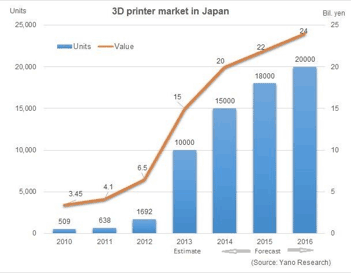3D printers a $10 billion market opportunity in 2020, but what's Japan's stake?
The Ministry of Economy, Trade and Industry (METI) predicted last February that the global market for 3D printers and materials will reach 1 trillion yen (US$10 billion*) in 2020, roughly quadrupling from 230 billion yen in 2012.
*Original figures are in Japanese yen. The exchange rate is roughly US$1=100 yen.
But Japan has a low profile in this rapidly growing market. Anxiety is mounting that even if a big new market emerges, Japan may wind up as a passive consumer of 3D printers and materials made elsewhere. So METI organized a national project, the Technology Research Association for Future Additive Manufacturing (TRAFAM)**, last April to boost development of 3D-related technology in Japan.
**The association was founded on April 1 by the National Institute of Advanced Industrial Science and Technology (AIST), two universities and 27 companies. METI earmarked 3.8 billion yen in this fiscal year's budget for operating expenses.
Compared to the big numbers forecast for the future global market, Japan's present-day 3D printer market is tiny. According to figures released by Tokyo-based Yano Research Institute last December, it amounted to 1,692 units or 6.5 billion yen in 2012, rose to 10,000 units or 15 billion yen last year, will reach 20,000 units or 24 billion yen in 2016, and thereafter will grow steeply through 2020.

Stratasys and 3D Systems, two American companies, are currently the major contenders, with more than 80% of the global 3D printer market.
Overseas suppliers have the lion's share of the Japanese market, too. The most popular 3D printers are those that employ fused deposition modeling (FDM) to fabricate 3D objects using inexpensive resin. Ever since the expiry of certain Stratasys' patents in 2009, low-cost printers targeting small companies and hobbyists have been commercialized one after another.
In 2020 consumer-oriented, low-priced 3D printers will account for 97% of the 40,000 units sold and half of total sales of 19.3 billion yen, according to Seed Planning, another research firm based in Tokyo. In view of the current dominance of foreign companies, there is growing concern in Japanese industry and government that the country risks becoming a mere consumer of imported printers and materials.
To raise Japan's profile in the burgeoning 3D printer market, the government-supported TRAFAM project was launched in April. 30 organizations, including equipment and material manufacturers, end-user companies and research outfits, have joined forces to develop printers and materials employing metal particles. The objective is development of equipment and materials for use on production lines to manufacture components.
Material development will focus not only on titanium, already widely used in industrial-strength 3D printing, but also on iron, copper, nickel, and cobalt particles. TRAFAM is generally viewed as an initiative vital for Japan's manufacturing industry, not least for the automotive sector.
In industrial circles, plenty of voices are trumpeting the value of the TRAFAM project, seeing it as a source of potentially powerful support for Japan's monozukuri*** capabilities. But others point out the importance of plastic resin materials, cautioning against succumbing once again to the Galapagos syndrome**** as the project seems to focus exclusively on equipment development. Furthermore, there are voices contending that if the government is serious about establishing a monozukuri-oriented economy, an entire ecosystem is needed to support the nascent 3D printing field, which is what appears to be emerging in the U.S.
***Monozukuri: METI defines the term as the art of making products that has supported Japanese culture and industry and helped to improve people's lives. In other words, manufacturing technology with value-added craftsmanship.
****An expression with negative connotations originally coined for the Japanese mobile phone market, whose development was advanced and unique but largely irrelevant to the global market. Similarly, the flora and fauna of the Galápagos Islands evolved separately from those in the rest of the world owing to their isolated habitat.
With a view to reaping the maximum benefit from the huge potential inherent in additive manufacturing or, as it is widely known, 3D printing, Japan needs to be flexible. Rather than becoming overly preoccupied with developing made-in-Japan equipment, Japan should cultivate an openness to the best new ideas from around the world.
Related press release:
The Study Group on New Monodzukuri Compiled a Report on the Ideal Approaches to Future Monodzukuri Derived from 3D Printers
Related sites:
TRAFAM (Japanese only)
The original article in Japanese by Mieko Sawanobori appeared in the June 25 issue of The Semiconductor Industry News. Edited and translated by EmergingTech, which added the notes and links.
Warning: Invalid argument supplied for foreach() in /home2/semicon/hosting/spiwww/include/Banner.php on line 78
Warning: array_multisort(): Argument #1 is expected to be an array or a sort flag in /home2/semicon/hosting/spiwww/include/Banner.php on line 81
Warning: Invalid argument supplied for foreach() in /home2/semicon/hosting/spiwww/include/Banner.php on line 85



